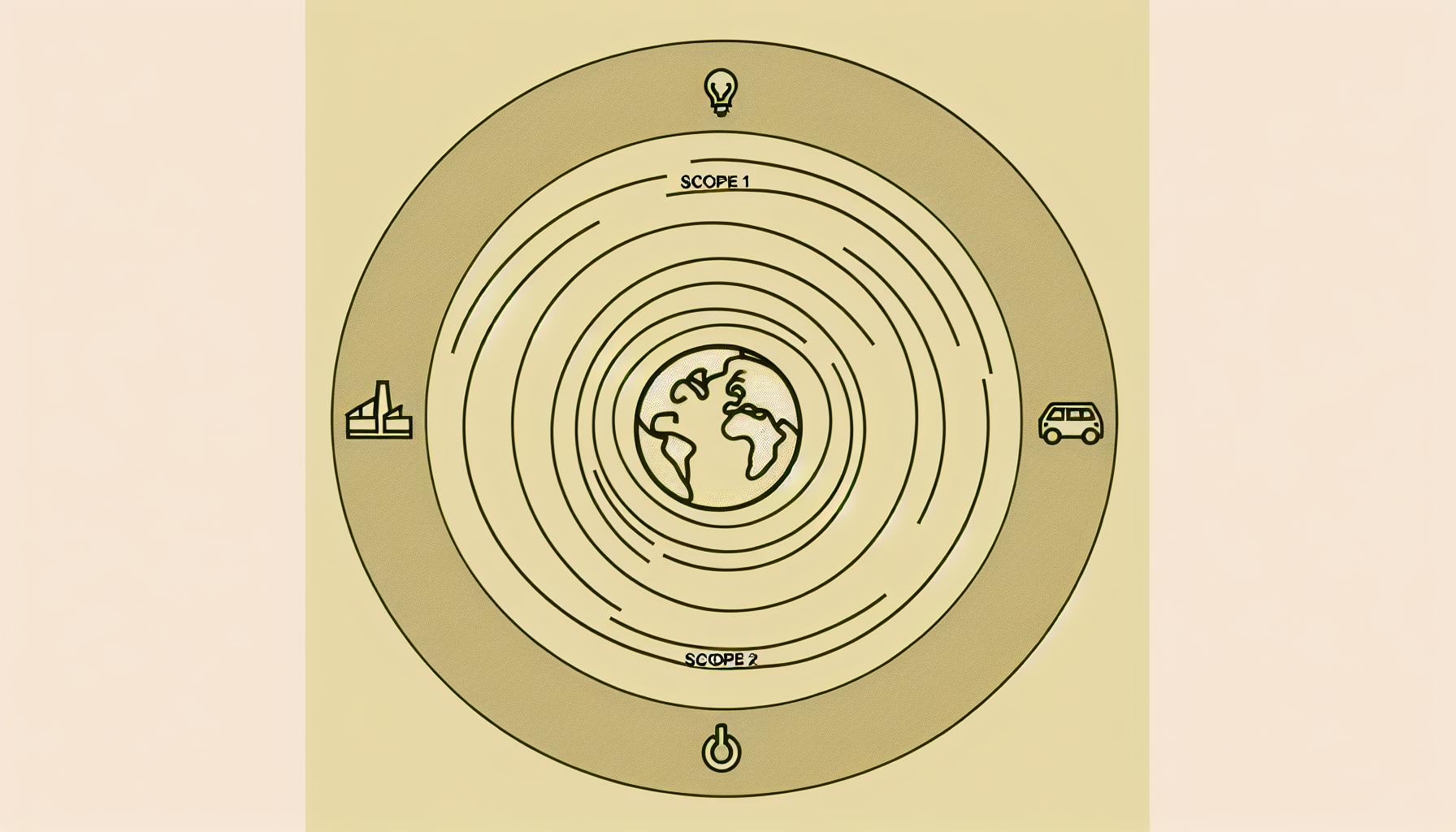Measuring direct emissions can seem daunting for SMEs focused on daily operations.
But with the right guidance, calculating and reducing your direct emissions is an achievable and rewarding path that delivers strategic benefits.
In this article, we'll demystify direct emissions, walk through measurement methodologies, explore reduction strategies, and showcase how insights gained create opportunities for efficiency improvements, cost savings, and communication of your organization's carbon commitment.
Deciphering Direct Emissions: An SME Introduction
Direct emissions, also known as scope 1 emissions, refer to greenhouse gas emissions that are released directly from sources owned or controlled by a company. For SMEs, understanding and measuring direct emissions is an important first step on the path towards sustainability.
This introductory guide will clarify what direct emissions are, why they matter specifically for SMEs, and provide actionable recommendations for how to get started measuring your company's carbon footprint. By the end, you'll have the key knowledge needed to take climate action.
Defining Direct Emissions in the SME Landscape
Direct emissions encompass carbon dioxide, methane, nitrous oxide, and other greenhouse gases that are emitted from [direct emissions examples] sources owned or controlled by a company, such as:
- Vehicles and machinery owned by the company
- On-site combustion in boilers, furnaces, generators
- Fugitive emissions from refrigeration and air conditioning
For SMEs in particular, direct emissions make up a significant portion of overall emissions. Company vehicles, deliveries, energy usage, and more all contribute.
Understanding direct emissions puts SMEs in greater control over decarbonization. As the saying goes: "What gets measured gets managed." By calculating scope 1 emissions specifically, SMEs open up targeted opportunities to switch vehicles, improve facilities, or update equipment.
Direct Emissions vs Carbon Emissions: Unraveling the Terms
It's easy to use "carbon emissions" and "direct emissions" interchangeably, but they have distinct meanings. Clarifying the terminology is key for SMEs embarking on sustainability initiatives.
- Carbon emissions refer broadly to any greenhouse gases released that contain carbon. This encompasses all scopes and sources.
- Direct emissions specifically mean scope 1 carbon emissions - only those directly emitted from company-owned sources.
[Direct emissions vs carbon footprint] provides further analysis on the nuances. Getting the definitions clear from the start enables accurate accounting and goal-setting.
Embarking on the Direct Emissions Measurement Journey
Once the key terminology is understood, SMEs can start their journey towards measuring direct emissions. Beginning with scope 1 sets a tangible goalpost.
Some first steps to take include:
- Catalog all direct emission sources (vehicles, equipment, sites, etc.)
- Research appropriate emissions factors and calculations
- Collect activity data (fuel consumed, kilometres driven, etc.)
- Use [direct emissions measurement tools] to track and analyze
The process will evolve over time as capabilities grow. Setting up initial scope 1 inventories and calculations puts SMEs on the right decarbonization trajectory.
With the foundations of direct emissions now demystified, SMEs have the knowledge to get started on sustainability initiatives. From here, the journey can expand into further scopes, goal-setting, and stakeholder engagement.
What is an example of direct emissions?
Direct emissions, also known as Scope 1 emissions, refer to greenhouse gas emissions that come directly from a company's owned or controlled sources. Some common examples include:
- Emissions from on-site fuel combustion in boilers, furnaces, generators, vehicles, etc. For instance, an office heating its building with natural gas would count the CO2 produced from burning that fuel as direct emissions.
- Fugitive emissions that leak during extraction, storage or transportation of fossil fuels like natural gas. Fugitive methane emissions from oil and gas infrastructure are a major contributor.
- Process emissions from physical or chemical processes like cement manufacturing that chemically transforms materials, releasing CO2.
- Emissions from company-owned transportation vehicles like delivery trucks or corporate jets. The tailpipe CO2 emissions would qualify as direct.
The key is that direct emissions originate from sources within a company's organizational boundaries and control. By understanding one's direct emissions, firms can devise targeted reduction strategies like improving energy efficiency or switching to renewable power. Taking accountability for direct emissions is the first step on the net zero journey.
What is an indirect emission?
Indirect emissions are those that result from an organization's activities but are actually emitted from sources owned by other entities. Scope 2 emissions are a type of indirect emission that accounts for greenhouse gases released in the production of electricity, steam, heat or cooling that is then purchased and consumed by the reporting organization.
Understanding indirect emissions enables companies to take responsibility for emissions along their entire value chain. Measuring scope 2 emissions specifically allows organizations to quantify and address emissions resulting from their energy usage. This represents an important step towards achieving net-zero emissions.
Some key points about indirect emissions:
- They allow companies to measure impacts beyond their direct operations
- Purchased energy often represents a major source of carbon emissions
- Reporting scope 2 emissions promotes transparency and accountability
- Managing scope 2 is crucial for effective carbon reduction strategies
Small and medium enterprises can leverage tools like EcoHedge to automatically track scope 2 emissions from purchased energy. This eliminates manual calculation while providing actionable insights to drive clean energy procurement and efficiency projects.
What are the direct sources of emissions?
Direct emissions, also known as scope 1 emissions, refer to greenhouse gases that are emitted directly from sources owned or controlled by a company. Some common direct emission sources for SMEs include:
- Combustion of fuels in boilers, furnaces, vehicles, generators, etc. owned by the company
- Production processes that chemically or physically transform materials (e.g. cement, aluminum, adipic acid production)
- Fugitive emissions from production and delivery of coal, oil, natural gas, from equipment like valves, pumps, compressors, etc.
To measure direct emissions, companies need to measure and collect data for all scope 1 emission sources. This includes fuel consumption data from meters or purchase receipts as well as direct emissions examples from industrial processes. Companies then use greenhouse gas calculation methodologies and emission factors to derive tCO2e emissions.
SMEs can take steps like improving energy efficiency, switching to renewable energy, changing industrial processes, and fixing leaks to reduce scope 1 emissions. Tracking direct emissions is the vital first step for SMEs to set emission reduction targets and make progress towards net zero.
Examples of Direct Emissions Sources
Here are some common examples of direct industrial emissions sources that SMEs should track:
- Stationary Combustion: Emissions from on-site combustion in boilers, furnaces, ovens, heaters, etc. run on fuels like natural gas, diesel, gasoline, coal, etc. This can make up a major share of an SME's carbon footprint.
- Mobile Combustion: Tailpipe exhaust emissions from vehicles, fork-lifts, machinery owned or leased by the company.
- Manufacturing Processes: Emissions from physical or chemical processes. Examples include CO2 from limestone calcination in cement plants, PFCs from aluminum smelting, N2O from adipic acid production, etc.
- Fugitive Emissions: Unintended GHG leaks and vents from industrial equipment like valves, pumps, compressor seals, flanges, etc. Main gases are methane and refrigerant chemicals.
sbb-itb-919600f
What are the 3 types of emissions?
Direct emissions, also known as Scope 1 emissions, refer to greenhouse gas emissions that are directly released from sources owned or controlled by a company. This includes emissions from fuel combustion in company vehicles and facilities, fugitive emissions from refrigerants in air conditioning units, and process emissions from chemical production or manufacturing activities.
Indirect emissions, known as Scope 2 emissions, account for greenhouse gas emissions that occur from the generation of purchased electricity consumed by a company. Though a company does not directly emit these greenhouse gases, it is responsible for the emissions that stem from its energy use.
The third category, Scope 3 emissions, encompasses all other indirect emissions across a company's entire value chain. This includes emissions from business travel, waste disposal, transportation logistics, raw material acquisition, product use, and more. Though challenging to quantify, understanding Scope 3 emissions is key for SMEs looking to reduce their overall climate impact.
Getting a breakdown of these three emissions scopes provides SMEs with the foundation for building an effective carbon management strategy. By focusing first on reductions in direct emissions, companies can tackle some of the most material emission sources under their control. As sustainability maturity increases, SMEs can then start addressing indirect Scope 2 and 3 emissions through renewable energy procurement, supplier engagement, and product life cycle assessments. With the right carbon accounting software, small businesses can seamlessly track emissions across all three scopes, identifying hotspots for reduction. The EcoHedge platform provides these capabilities through automated data collection, emissions factor allocation, and detailed reporting. By decoding direct, indirect, and value chain emissions, SMEs can embark on their net zero journey with confidence.
Navigating the Numbers: Calculating Your Direct Emissions
As an SME seeking to reduce your environmental impact, accurately measuring your company's direct greenhouse gas (GHG) emissions is an essential first step. Direct emissions refer specifically to GHG emissions from sources owned or controlled by your company.
To measure your direct emissions, you'll need to quantify emissions associated with fuel combustion from boilers or furnaces, fleet vehicles you own and operate, and any manufacturing or chemical production processes. While this can seem daunting initially, following GHG accounting standards and using available emissions calculation tools can simplify the process.
Direct Emissions Calculation Tools for SMEs
Familiar standards like the Greenhouse Gas Protocol provide straightforward calculation methods and emissions factors tailored for small businesses. Many user-friendly carbon accounting software options also exist to seamlessly track direct emissions across your operations.
With the right tools, calculating emissions from the fuel and electricity used in your offices and warehouses or from the operation of a corporate vehicle fleet does not require advanced expertise. Consider leveraging solutions purpose-built for the SME context to efficiently comply with reporting needs.
Direct Emissions Examples: From Theory to Practice
To make direct emissions calculations more tangible, let's walk through a practical example. Imagine an SME called EcoProducts that manufacturers reusable grocery bags and has 50 employees.
When tallying its direct emissions, EcoProducts would need to account for its main production processes on-site, any directly controlled boilers or generators, and emissions from its delivery vans used for transportation. By reporting usage data for these sources into emissions software, EcoProducts can automatically generate its direct emissions profile.
Tallying Up Your Carbon Footprint: Direct Emissions Considerations
While direct emissions quantify one important piece, a company's total GHG emissions or "carbon footprint" encapsulates direct emissions plus all indirect emissions across the value chain.
So in EcoProduct's case, the materials and electricity used during manufacturing would contribute to indirect or Scope 3 emissions. To comprehensively track its footprint, EcoProducts would need to look beyond its direct operational control to its supply chain and the full lifecycle of its products. We'll explore indirect emissions in more detail in the sections to follow!
Strategies for Direct Emissions Reduction
Reducing direct emissions is a key part of any business's sustainability journey. For SMEs, implementing strategies to decrease emissions from owned or controlled emission sources offers both environmental and economic benefits. This section explores practical approaches to reduce direct emissions across business operations.
Renewable Solutions for Direct Energy Sources
Transitioning to renewable energy sources allows companies to dramatically cut direct emissions resulting from on-site energy use. Installing solar panels or wind turbines enables businesses to generate clean power. If on-site renewables are not feasible, signing green energy supply contracts can source electricity from renewable generators.
For example, EcoHedge uses 100% renewable energy to power its offices and cloud infrastructure. This alone reduced the company's direct emissions by over 80% in 2021. Their experience shows that renewable energy delivers tangible emission reductions and long-term savings.
Greening Your Fleet: Transportation and Direct Emissions
Transportation sources like company vehicles and corporate air travel are major direct emission sources. Optimizing fleets and revising travel policies can significantly reduce associated emissions.
Upgrading to hybrid or electric vehicles, facilitating carpooling, and enabling remote work arrangements are impactful interventions. EcoHedge implemented flexible remote work and virtual meeting practices, decreasing travel requirements by 75% year-over-year. This vastly reduced direct emissions without affecting productivity.
Direct Emissions and Indirect Benefits: Beyond Emission Reductions
While the core motivation is environmental, curbing direct emissions also yields other organizational rewards. Switching to renewables slashes energy costs over time. Fleet optimization and travel policy changes generate substantial cost savings on transport and operations.
Moreover, sustainability leadership amplifies brand reputation. EcoHedge has built brand trust and loyalty by publicly sharing its direct emission stats and reduction strategies. This transparency enables stakeholders to track progress and builds ecosystem support.
In summary, reducing direct emissions through renewable energy procurement, fleet electrification, travel policy revision and stakeholder engagement generates quantifiable sustainability and business returns. Prioritizing emission cuts creates cascading co-benefits over time.
Direct Emissions and Beyond: Understanding Indirect Impacts
Direct emissions, also known as scope 1 emissions, refer to greenhouse gas emissions that are released directly from sources owned or controlled by an organization. However, most businesses also have significant indirect emissions resulting from activities in their value chain. Understanding the differences between direct and indirect emissions is key for small and medium enterprises (SMEs) looking to comprehensively manage their carbon footprint.
Distinguishing Scope 2 and Scope 3 Emissions from Direct Emissions
While direct emissions come from an organization's own operations, indirect emissions fall into two categories:
- Scope 2 emissions are associated with the electricity an organization consumes. Although not released directly by the organization, these emissions are a consequence of its energy use.
- Scope 3 emissions cover all other indirect emissions from an organization's value chain. This includes emissions from purchased goods and services, transportation, waste disposal, employee commuting, investments, and more.
For many SMEs, scope 3 emissions make up the majority of their carbon footprint. While direct emissions may seem more tangible, narrowly focusing on them risks overlooking larger indirect impacts.
The Interplay Between Direct Emissions and Carbon Footprint
An SME's carbon footprint encompasses all direct and indirect emissions, across scope 1, 2 and 3. The relationship between direct emissions and carbon footprint depends on the business:
- For a manufacturer, direct emissions from on-site fossil fuel combustion may dominate.
- For an online retailer, scope 3 emissions from shipping could outweigh direct impacts.
Either way, direct emissions always contribute to an SME's carbon footprint. But for holistic footprint management, both direct and indirect emissions need addressing.
Tackling Indirect Emissions: Scope 2 and 3 Strategies for SMEs
SMEs shouldn't see indirect emissions as out of reach. Despite the challenges of data collection and boundary setting, steps can be taken, including:
- Understanding your footprint - Identify major scope 3 hotspots through footprinting exercises.
- Supplier engagement - Work with value chain partners to reduce embodied emissions.
- Off-setting - Offset residual indirect emissions through verified carbon schemes.
Indirect emissions offer further opportunities for SMEs to reduce supply chain impacts, engage stakeholders and communicate achievements – allowing small businesses to think big on sustainability.
Capitalizing on Direct Emissions Insights for Strategic Gain
Understanding direct emissions enables SMEs to make informed decisions that benefit both sustainability and strategic growth. By setting ambitious yet achievable emission reduction targets, uncovering savings through efficiency analysis, and effectively communicating sustainability commitment, SMEs can leverage direct emissions data for competitive advantage.
Setting the Bar with Science-Based Targets
Direct emissions provide the baseline data needed to set science-based targets aligned with climate science. SMEs should:
- Measure direct emissions from owned or controlled emission sources per established protocols
- Set emission reduction targets consistent with keeping global temperature rise below 1.5°C
- Commit to regular measurement and progress tracking
Adopting ambitious, science-aligned targets demonstrates environmental leadership and credibility.
Uncovering Efficiency Goldmines Through Direct Emissions Analysis
Detailed direct emissions assessment reveals hotspots for energy, fuel, and process efficiency gains. SMEs should:
- Break down direct emissions data by source, activity, facility to pinpoint heavy emitters
- Identify potential technology upgrades, optimizations, or process changes to curb emissions
- Continuously analyze direct emissions to uncover new savings opportunities
Efficiency improvements can significantly cut costs while advancing sustainability aims.
Communicating Carbon Commitments: Direct Emissions in ESG Narratives
Direct emissions performance and reduction targets are key pieces in demonstrating commitment to environmental stewardship. SMEs should highlight in sustainability reports for stakeholders:
- Baseline direct emissions levels
- Science-based or approved emission reduction goals
- Plans and progress to meeting stated targets
Transparent communication establishes trust and confidence in sustainability initiatives.
With robust emissions measurement programs and strategic use of resultant data, SMEs can capitalize on decarbonization opportunities for competitive and sustainable growth.



